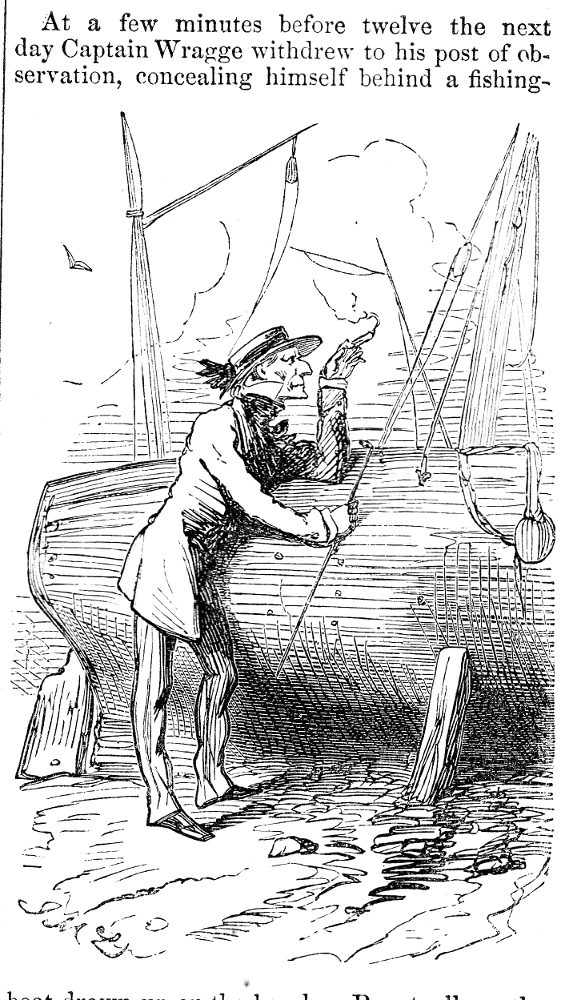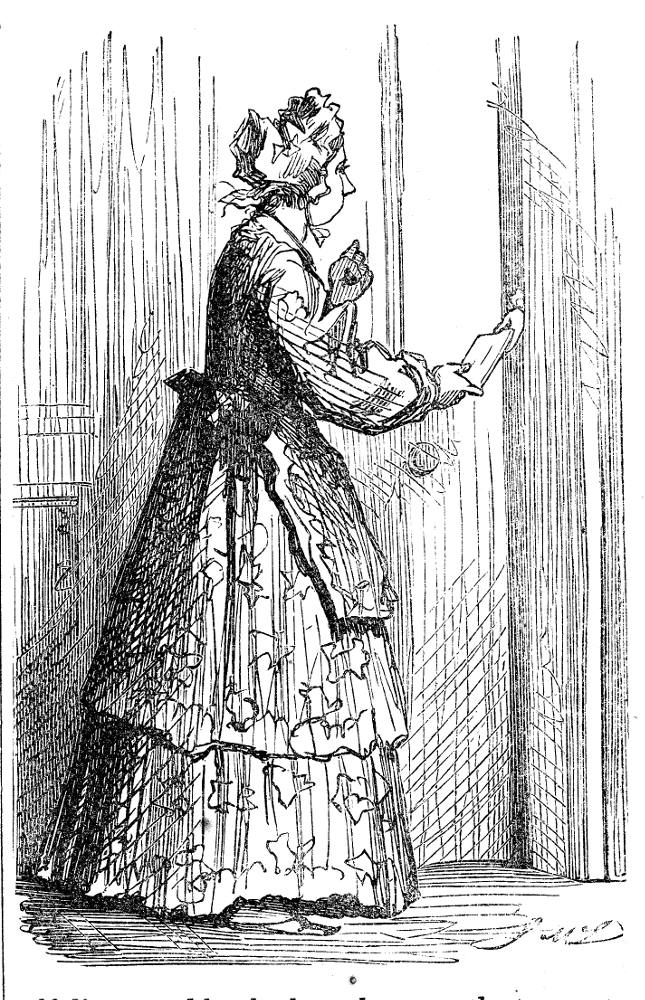

“My colour will.” Wood-engraving 11.6 cm high by 11.5 cm wide, or 4 ½ inches square, framed, for instalment twenty-six in the American serialisation of Wilkie Collins’s No Name in Harper’s Weekly [Vol. VI. — No. 294] Number 26, “The Fourth Scene — Aldborough, Suffolk.” Chapter VII (page 573; p. 162 in volume), plus an uncaptioned vignettte of Captain Wragge, hiding behind a fishing vessel (p. 573; p. 165 in volume): 11 cm high by 5.6 cm wide, or 4 ¼ inches high by 2 ¼ inches wide, vignetted. [Instalment No. 26 ends in the American serialisation on page 575, at the end of Chapter VII. Precisely the same number without illustration ran on 6 September 1862 in All the Year Round.]
Main Illustration: Wragge is determined to Hide Magdalen’s Distinctive Moles
“We are on the brink of detection,” proceeded the captain, carefully mixing his colors with liquid glue, and with a strong “drier” added from a bottle in his own possession. “There is only one chance for us (lift up your hair from the left side of your neck) — I have told Mr. Noel Vanstone to take a private opportunity of looking at you; and I am going to give the lie direct to that she-devil Lecount by painting out your moles.”
“They can’t be painted out,” said Magdalen. “No color will stop on them.”
“My color will,” remarked Captain Wragge. “I have tried a variety of professions in my time — the profession of painting among the rest. Did you ever hear of such a thing as a Black Eye? I lived some months once in the neighborhood of Drury Lane entirely on Black Eyes. My flesh-color stood on bruises of all sorts, shades, and sizes, and it will stand, I promise you, on your moles.”
With this assurance, the captain dipped his brush into a little lump of opaque color which he had mixed in a saucer, and which he had graduated as nearly as the materials would permit to the color of Magdalen’s skin. [“The Fourth Scene — Aldborough, Suffolk.” Chapter VII: in the American serialisation, p. 575; p. 162 in volume]
Vignette Illustration: Wragge’s Positioning Himself behind a Fishing Boat on the Beach
At a few minutes before twelve the next day Captain Wragge withdrew to his post of observation, concealing himself behind a fishing-boat drawn up on the beach. Punctually as the hour struck, he saw Noel Vanstone approach North Shingles and open the garden gate. When the house door had closed on the visitor, Captain Wragge settled himself comfortably against the side of the boat and lit his cigar.
He smoked for half an hour — for ten minutes over the half-hour, by his watch. He finished the cigar down to the last morsel of it that he could hold in his lips. Just as he had thrown away the end, the door opened again and Noel Vanstone came out. [“The Fourth Scene — Aldborough, Suffolk.” Chapter VII: in the American serialisation, p. 576; p. 165 in volume]
Commentary: The Value and Purpose of the Vignettes Versus Those of the Regular Plates

Despite the numerous opportunities for including realia and Victorian bric-a-brac that interior scenes presented, McLenan often seems to have been more inspired by exterior locations in the American serialisation of Collins’s 1862 Sensation novel. The vignette of the beach scene here, for example, seems more visually engaging than the drawing-room scenes in instalments 26 and 27, although those larger cuts usually do more to advance our understanding of the plot and the characters’ motivations. The principal function of the vignette, then, remains to pique the reader’s interest, to compel the serial reader in particular to discover the meaning of the vignetted image, to discover, for example, why Wragge is hiding behind a fishing-boat, or what are the contents of the letter being hand-delivered to Mrs. Lecount in the next instalment, as well, of course, as whose hand is passing the letter through the door.
Inevitably, the larger questions that the serial novelist poses his readers are prompted by the full-size wood-engravings and their telling captions. What, for example, does the Captain mean when he tells Magdalen, “My color will,” as if he has theatrical makeup that is somehow superior to hers. Only a careful perusal of the accompanying letterpress will furnish the answers, and reveal the connection between the two weekly illustrations.
In the main illustration for 6 September 1862, Wragge must act quickly to dupe Noel Vanstone. Suspecting that the housekeeper has acquired a detailed physical description of Magdalen from Miss Garth, Captain Wragge determines to thwart Mrs. Lecount’s plan at its weakest point. Rushing upstairs to Magdalen’s room, he asks her to fetch her stage makeup kit. Although much of the description could be applied to any attractive young woman with light-brown hair and grey eyes, her three moles on the neck are highly distinctive. Accordingly, Wragge determines to use his own expertise with makeup to disguise the distinctive moles, so that even at a close inspection Noel Vanstone will be unable to detect them. What the Captain means by “my colour,” then, is that he has a bonding agent that will fix the disguising makeup so that the moles will not be discernible. Accordingly, then, Noel Vanstone will shortly conclude that “Susan Bygrave” is not “Magdalen Vanstone.”
In what way, other than Captain Wragge’s obvious presence in both, are these illustrations connected? The unmistakable swindler and confidence man is instantly recognizable, constantly plotting and taking countermeasures against his adversary, Noel Vanstone’s Swiss housekeeper. In the main illustration, he is very much emotionally and intellectually engaged, whereas Magdalen, his fellow-plotter, is curiously aloof. Both sets of plates underscore the Captain's discretion, for he knows when to act or intervene (as with the rapid application of the makeup), and when to merely observe (as with the blind signal that he has stationed himself to observe from the beach).
Image scans and text by Philip V. Allingham. [You may use the images without prior permission for any scholarly or educational purpose as long as you (1) credit the person who scanned them image and (2) link your document to this URL in a web document or cite the Victorian Web in a print one.]
Bibliography
Blain, Virginia. “Introduction” and “Explanatory Notes” to Wilkie Collins's No Name. Oxford World's Classics. Oxford: Oxford University Press, 1986.